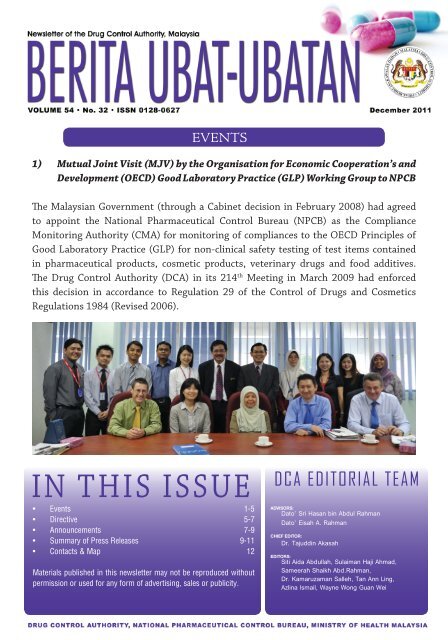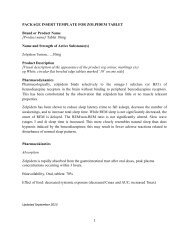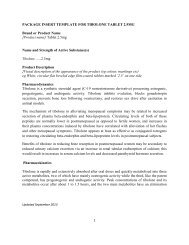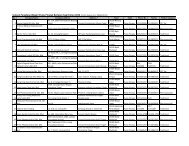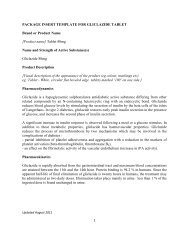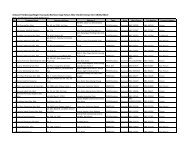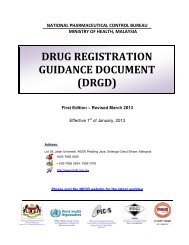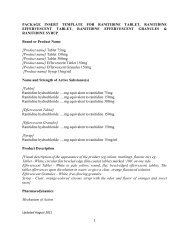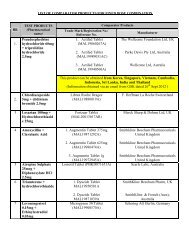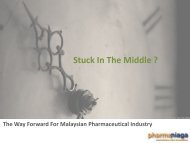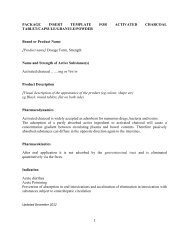to appoint the National Pharmaceutical Control Bureau ... - BPFK
to appoint the National Pharmaceutical Control Bureau ... - BPFK
to appoint the National Pharmaceutical Control Bureau ... - BPFK
You also want an ePaper? Increase the reach of your titles
YUMPU automatically turns print PDFs into web optimized ePapers that Google loves.
EVENTS1) Mutual Joint Visit (MJV) by <strong>the</strong> Organisation for Economic Cooperation’s andDevelopment (OECD) Good Labora<strong>to</strong>ry Practice (GLP) Working Group <strong>to</strong> NPCBThe Malaysian Government (through a Cabinet decision in February 2008) had agreed<strong>to</strong> <strong>appoint</strong> <strong>the</strong> <strong>National</strong> <strong>Pharmaceutical</strong> <strong>Control</strong> <strong>Bureau</strong> (NPCB) as <strong>the</strong> ComplianceMoni<strong>to</strong>ring Authority (CMA) for moni<strong>to</strong>ring of compliances <strong>to</strong> <strong>the</strong> OECD Principles ofGood Labora<strong>to</strong>ry Practice (GLP) for non-clinical safety testing of test items containedin pharmaceutical products, cosmetic products, veterinary drugs and food additives.The Drug <strong>Control</strong> Authority (DCA) in its 214 th Meeting in March 2009 had enforcedthis decision in accordance <strong>to</strong> Regulation 29 of <strong>the</strong> <strong>Control</strong> of Drugs and CosmeticsRegulations 1984 (Revised 2006).IN THIS ISSUE• Events 1-5• Directive 5-7• Announcements 7-9• Summary of Press Releases 9-11• Contacts & Map 12Materials published in this newsletter may not be reproduced withoutpermission or used for any form of advertising, sales or publicity.DCA EDITORIAL TEAMADVISORS:Da<strong>to</strong>’ Sri Hasan bin Abdul RahmanDa<strong>to</strong>’ Eisah A. RahmanCHIEF EDITOR:Dr. Tajuddin AkasahEDITORS:Siti Aida Abdullah, Sulaiman Haji Ahmad,Sameerah Shaikh Abd.Rahman,Dr. Kamaruzaman Salleh, Tan Ann Ling,Azlina Ismail, Wayne Wong Guan Wei
N E W S L E T T E R O F T H E D R U G C O N T R O L A U T H O R I T Y , M A L A Y S I AMalaysia had been accepted as a provisional member of <strong>the</strong> OECD Mutual Acceptanceof Data (MAD) in Oc<strong>to</strong>ber 2008. Since <strong>the</strong>n, NPCB had developed its GLP ComplianceMoni<strong>to</strong>ring Programme. The programme describes <strong>the</strong> organisation and structure,policies, processes and procedures in managing <strong>the</strong> GLP compliance moni<strong>to</strong>ringprogramme in Malaysia. NPCB had conducted a number of GLP inspections at nonclinicaltest facilities in Malaysia and <strong>to</strong> date, 2 test facilities were in <strong>the</strong> programme.The assessment on NPCB’s GLP Compliance Moni<strong>to</strong>ring Programme was conductedthrough Mutual Joint Visit (MJV) on 14 th -19 th November 2011. The purpose of <strong>the</strong>MJV was <strong>to</strong> evaluate NPCB’s programme and <strong>the</strong> inspec<strong>to</strong>rs’ competencies in performingGLP inspection. The MJV team consisted of evalua<strong>to</strong>rs from United Kingdom (leadevalua<strong>to</strong>r), Switzerland and Japan. An OECD secretariat was also present during <strong>the</strong>MJV. Environment Technology and Research Centre (ETRC) of SIRIM Berhad, ShahAlam was chosen as <strong>the</strong> facility for inspection by <strong>the</strong> team.Preliminary results from <strong>the</strong> MJV were very encouraging. No major issue of noncomplianceswas found in NPCB during <strong>the</strong> MJV. The MJV team will recommendMalaysia <strong>to</strong> <strong>the</strong> OECD GLP Working Group which will be held in May 2012 (in Paris) asa Full Member of <strong>the</strong> OECD MAD for GLP. With <strong>the</strong> full membership, non-clinical dataconducted by a test facility in <strong>the</strong> NPCB GLP Compliance Programme shall be accepted byall OECD countries and Non-OECD countries that adhere <strong>to</strong> GLP MAD System.2) WHO Training Workshop on <strong>the</strong> Quality Assessment of Active <strong>Pharmaceutical</strong>Ingredients (API) & Awareness Seminar on Regula<strong>to</strong>ry <strong>Control</strong> of APIThe NPCB had organised <strong>the</strong> WHO Training Workshop on <strong>the</strong> Quality Assessment ofActive <strong>Pharmaceutical</strong> Ingredients (API) on 29 th – 30 th September 2011 and <strong>the</strong> AwarenessSeminar on Regula<strong>to</strong>ry <strong>Control</strong> of API on 1 st Oc<strong>to</strong>ber 2011. The regula<strong>to</strong>ry control of APIwill be implemented manda<strong>to</strong>rily in January 2012 (starting with new chemical entities).Objectives of <strong>the</strong> seminar and workshop:• Disseminate current information on<strong>to</strong> <strong>the</strong> industry regarding <strong>the</strong> regula<strong>to</strong>ry control of APIs aspart of <strong>the</strong> requirements in <strong>the</strong> product registration application;• Streng<strong>the</strong>n <strong>the</strong> competency among regula<strong>to</strong>ry officers in assessing technical quality informationof APIs.2
N E W S L E T T E R O F T H E D R U G C O N T R O L A U T H O R I T Y , M A L A Y S I Ai. Training WorkshopA <strong>to</strong>tal of 47 participants comprising of regula<strong>to</strong>ry officers from Malaysia (NPCB),Singapore (Health Science Authority), Indonesia (<strong>National</strong> Agency for Drug and Food<strong>Control</strong>) and Brunei attended this workshop.Lecturers were given by speakers from WHO. Representatives from Indonesia, Singaporeand Brunei were given <strong>the</strong> chance <strong>to</strong> share relevant information regarding <strong>the</strong> regula<strong>to</strong>rycontrol of APIs in <strong>the</strong>ir respective countries. Participants were divided in<strong>to</strong> six groupsduring group work sessions where <strong>the</strong>y were assigned <strong>to</strong> assess <strong>the</strong> Drug Master Filebased on <strong>the</strong> lectures given.ii. SeminarThe seminar was organised in collaboration with WHO and <strong>the</strong> Malaysian <strong>Pharmaceutical</strong>Society (MPS). It was attended by 186 participants (mostly representatives frompharmaceutical industry).The seminar started with an opening speech by Mdm. Siti Aida Abdullah, Deputy Direc<strong>to</strong>rof <strong>the</strong> Centre for Product Registration, NPCB followed by talks from a local speaker aswell as three WHO speakers namely Dr. Milan Smid, Dr. An<strong>to</strong>ny Fake and Dr. JurgenSchomakers. It was concluded with a closing remark by Mdm. Rosilawati Ahmad fromNPCB and a speech from Dr. Milan Smid.3
N E W S L E T T E R O F T H E D R U G C O N T R O L A U T H O R I T Y , M A L A Y S I A3) WHO Consultative Meeting on Combating Substandard / Spurious / Falselylabelled/ Falsified / Counterfeit (SSFFC) Medicines and Building GlobalCapacity for Surveillance and Moni<strong>to</strong>ring of SSFFCThe NPCB was given <strong>the</strong> honour <strong>to</strong> host <strong>the</strong> 2 nd WHO Consultative Meeting on CombatingSubstandard / Spurious / Falsely-labelled / Falsified / Counterfeit (SSFFC) Medicines andBuilding Global Capacity for Surveillance and Moni<strong>to</strong>ring of SSFFC which was held on3 rd – 5 th Oc<strong>to</strong>ber 2011 in Kuala Lumpur. The 1 st consultative meeting for <strong>the</strong> EuropeanRegion has been held in Kiev in June 2011. The objectives of <strong>the</strong> meeting were:• To update <strong>the</strong> current situation of counterfeit and substandard medicines at <strong>the</strong>regional and global level and <strong>to</strong> share experiences and good practices in combating<strong>the</strong>m;• To review <strong>the</strong> existing surveillance and reporting system of <strong>the</strong> counterfeit andsubstandard products, at <strong>the</strong> regional and <strong>the</strong> global levels, including <strong>the</strong> RegionalRapid Alert System (RAS) for combating counterfeit medicines;• To discuss <strong>the</strong> WHO project on Building Global Capacity for Surveillance andmoni<strong>to</strong>ring of substandard and counterfeit medicines and <strong>to</strong> explore <strong>the</strong> participationof regula<strong>to</strong>ry authorities of <strong>the</strong> Member Countries in <strong>the</strong> Western Pacific and SouthEast Asian region of WHO;• To discuss <strong>the</strong> development and piloting of a global system for surveillance andmoni<strong>to</strong>ring of substandard and counterfeit medicines.4
N E W S L E T T E R O F T H E D R U G C O N T R O L A U T H O R I T Y , M A L A Y S I AThis meeting was attended by delegates from Indonesia, Malaysia, Myanmar, Thailand,Philippines, Cambodia, Lao DPR, Vietnam, China, Mongolia, Ukraine, Azerbaijan andRussian Federation. Representatives from <strong>the</strong> World Health Organisation (WHO) and<strong>the</strong> United States Food and Drug Administrations (FDA) were also present.The outcome of this meeting would be used by WHO <strong>to</strong> develope a global data base withsystematic information of SSFFC medicines.Agenda of <strong>the</strong> Meeting:i. Presentations on country experiences of surveillance and moni<strong>to</strong>ring of ‘substandard / spurious /falsely-labelled / falsified / counterfeit (SSFFC)’ medicines.ii. Discussion on <strong>the</strong> needs of Regula<strong>to</strong>ry Authorities of participating countries in identification ofSSFFC medicines that have entered or that threaten <strong>to</strong> enter <strong>the</strong>ir countries’ supply chain.iii. Presentation on <strong>the</strong> best practices for reporting of cases of SSFFC medicines, <strong>to</strong> facilitate commonunderstanding and unification of minimum standards needed for individual case reports.DIRECTIVE1) Directive 13/2011: Compulsory Submission of Notification by Bioequivalence(BE) Study Centres <strong>to</strong> NPCB for All BE Studies That Do Not Require ClinicalTrial Import License (CTIL) / Clinical Trial Exemption (CTX)A directive under Regulation 29 of <strong>the</strong> <strong>Control</strong> of Drugs and Cosmetics Regulations 1984(Revised 2006) had been issued by <strong>the</strong> Senior Direc<strong>to</strong>r of <strong>Pharmaceutical</strong> Services, Da<strong>to</strong>’Eisah A. Rahman following decisions made by <strong>the</strong> Drug <strong>Control</strong> Authority (DCA) in its244 th Meeting on 26 th September 2011. Bioequivalence (BE) study centres are required <strong>to</strong>submit notification <strong>to</strong> NPCB for all BE studies that do not require Clinical Trial ImportLicense (CTIL) / Clinical Trial Exemption (CTX) (which will be conducted at ei<strong>the</strong>r local orforeign BE study centres) for registered products as well as products that will be registeredin Malaysia.5
N E W S L E T T E R O F T H E D R U G C O N T R O L A U T H O R I T Y , M A L A Y S I AThe directive will be enforced from 1 st January 2012 onwards and shall include allapplications for <strong>the</strong> registration of new products.All product registration holders are instructed <strong>to</strong> comply with this requirement.Implementationa) <strong>Pharmaceutical</strong> company that wish <strong>to</strong> conduct BE study that do not require CTIL / CTX at localBE study centre.Documents required:i. Study Pro<strong>to</strong>colii. Clinical study registration number from <strong>the</strong> <strong>National</strong> Medical Research Registry (NMRR)iii. Approval from relevant ethics committee (recognized by <strong>the</strong> DCA)b) Local pharmaceutical company that wish <strong>to</strong> conduct BE study at foreign BE study centreDocuments required:i. Study Pro<strong>to</strong>colii. Clinical study registration number from <strong>the</strong> country where <strong>the</strong> BE study is conducted,iii. eg, NMRR, WHO International Clinical Trials Registry Platform(ICTRP), European ClinicalTrial Database (EudraCT), Clinical Trial Registry-India (CTRI) ando<strong>the</strong>rs.iv. Approval from ethics committee from <strong>the</strong> country where <strong>the</strong> BE study is conducted.v. Approval from <strong>the</strong> <strong>National</strong> Regula<strong>to</strong>ry Authority of <strong>the</strong> country where <strong>the</strong> BE study isconducted (if any).vi. A copy of certificate of accreditation (for <strong>the</strong> BE study Centre) from <strong>the</strong> regula<strong>to</strong>ry agency of<strong>the</strong> country where <strong>the</strong> BE study isconducted; or a confirmation letter issued by <strong>the</strong> regula<strong>to</strong>ryagency of <strong>the</strong> country (stating <strong>the</strong> recognition of <strong>the</strong> BE study centre).6
N E W S L E T T E R O F T H E D R U G C O N T R O L A U T H O R I T Y , M A L A Y S I AThe notification for all cosmetic products containing o-Aminophenol will be cancelled(after 3 rd January 2012). Hence, <strong>the</strong> notification holders should ensure that:i) The existing s<strong>to</strong>ck in <strong>the</strong> market is cleared before 3 rd January 2012.ii) The remaining s<strong>to</strong>ck of existing products in <strong>the</strong> market (if any) is recalled within 30days (after 3 rd January 2012) followed by proper disposal.In order <strong>to</strong> ensure that products containing o-Aminophenol are no longer marketedafter <strong>the</strong> specified date above, notification holders are advised not <strong>to</strong> apply for any newnotification for products containing this substance. It is <strong>the</strong> responsibility of notificationholders <strong>to</strong> comply with all <strong>the</strong> legislations and regulations under Regulation 29, <strong>the</strong><strong>Control</strong> of Drugs and Cosmetics Regulations 1984 as well as Guidelines for <strong>Control</strong> ofCosmetic Products in Malaysia.Did You Know?Until <strong>the</strong> early 1900s, hair dye was made from a wide range of herbal and natural dyes.French chemist Eugene Schuller created <strong>the</strong> first safe commercial hair dye in 1909. Hisinvention was based on a chemical known as paraphenylenediamine. In 1932, hair dye wasfur<strong>the</strong>r refined by Lawrence Gelb who created hair dye that actually penetrated <strong>the</strong> shaft of<strong>the</strong> hair.2) Changes in Traditional Product Sample Quantity for <strong>the</strong> Purpose of Labora<strong>to</strong>ryTestingThe NPCB would like <strong>to</strong> inform all traditional product registration holders andmanufacturers regarding changes in <strong>the</strong> quantity of samples for traditional products thathave <strong>to</strong> be sent <strong>to</strong> <strong>the</strong> Centre for Quality <strong>Control</strong> for labora<strong>to</strong>ry testing. The changes wereas follows:i. 6 separate containers for all dosage forms, orii. 60 pieces of patches or plasters with a <strong>to</strong>tal content of not less than 200 gramsor 200mL.8
N E W S L E T T E R O F T H E D R U G C O N T R O L A U T H O R I T Y , M A L A Y S I AThese changes were made <strong>to</strong> meet <strong>the</strong> requirements of MS ISO / IEC17025:2005 and <strong>the</strong> standard requirements of <strong>the</strong> United States Pharmacopeia (USP)for weight uniformity testing. Hence, all parties involved are urged <strong>to</strong> follow <strong>the</strong> newrequirements while waiting for <strong>the</strong> updated Drug Registration Guidance Document(DRGD) <strong>to</strong> be uploaded on<strong>to</strong> <strong>the</strong> NPCB website.SUMMARY OF PRESS RELEASES1) Response <strong>to</strong> Newspaper Articles Regarding <strong>the</strong> Safety of Johnson’s BabyShampoo- SIN CHEW DAILY (1ST NOVEMBER 2011):CONSUMERS OF THE UNITED STATES BOYCOTT JOHNSON & JOHNSON BABY SHAMPOOBECAUSE IT CONTAINS CANCER CAUSING INGREDIENT- GUANG MING DAILY (2ND NOVEMBER 2011):US JOHNSON’S BABY SHAMPOO ACCUSED TO BE CANCER-CAUSINGRETAILERS HAVE NOT RECEIVED NOTIFICATION TO REMOVE PRODUCTS FROM SHELF- CHINA PRESS (2ND NOVEMBER 2011):JOHNSON’S BABY SHAMPOO FOUND TO CONTAIN CARCINOGENIC SUBSTANCE INHONG KONGThe local newspaper reports stated above were based on a statement issued byThe Campaign for Safe Cosmetics in United States (on 1 st November 2011). It wasreported that Johnson’s Baby Shampoo found in <strong>the</strong> market in several countries stillcontains Quaternium-15. It was claimed that <strong>the</strong> amount of formaldehyde produced byQuaternium-15 in this product can cause cancer.9
N E W S L E T T E R O F T H E D R U G C O N T R O L A U T H O R I T Y , M A L A Y S I AJohnson’s Baby Shampoo is notified with <strong>the</strong> <strong>National</strong><strong>Pharmaceutical</strong> <strong>Control</strong> <strong>Bureau</strong> and it containsQuaternium-15 at a concentration of 0.05% whichis within <strong>the</strong> permissible limit. It also complies with<strong>the</strong> Guidelines for <strong>Control</strong> of Cosmetic Products inMalaysia as well as <strong>the</strong> ASEAN Cosmetic Directive.Quarternium-15 is allowed in cosmetic productformulations as a preservative (at concentrations ofup <strong>to</strong> 0.2%). Formaldehyde is also allowed in cosmeticsformulations as a preservative with concentrations ofup <strong>to</strong> 0.1% for oral hygiene preparations and up <strong>to</strong> 0.2%for o<strong>the</strong>r cosmetic products. This limit had been deemedsafe for use in cosmetics by various regula<strong>to</strong>ry agencies.Therefore, <strong>the</strong> use of <strong>the</strong>se substances in accordance <strong>to</strong><strong>the</strong> required terms and conditions is allowed by mostcountries including European countries, United States,China and ASEAN countries.The same issue regarding <strong>the</strong> safety of Johnson’s Baby Shampoo had been reported inlocal newspapers back in 2009 and <strong>the</strong> Ministry of Health had also responded that thisproduct is safe for use. To date, no report involving <strong>the</strong> safety issue of such substance incosmetics has been received.The NPCB has been continuously moni<strong>to</strong>ring cosmetic products in <strong>the</strong> market through<strong>the</strong> Post Marketing Surveillance Programme <strong>to</strong> ensure <strong>the</strong> safety and quality of <strong>the</strong>seproducts.10
N E W S L E T T E R O F T H E D R U G C O N T R O L A U T H O R I T Y , M A L A Y S I A2) Cancellation of Registration for Traditional Product “Twee Hong Suah” due <strong>to</strong>High Mercury LevelThe DCA had cancelled <strong>the</strong> registration of atraditional product namely Twee Hong Suah(MAL20034112T) as it was found <strong>to</strong> exceed<strong>the</strong> permitted mercury limit in traditionalproducts. The marketing authorisation holderand manufacturer, Hong Yang Hoo PharmaSdn. Bhd. (Penang) had been ordered <strong>to</strong>s<strong>to</strong>p <strong>the</strong> sale / supply of Twee Hong Suahimmediately and recall all s<strong>to</strong>cks from <strong>the</strong>market.Twee Hong Suah was traditionally used for<strong>the</strong> symp<strong>to</strong>matic relief of flatulence, s<strong>to</strong>machache,mild vomiting, mild diarrhea, cough andfever in children.Mercury is a heavy metal that may cause poisoning if consumed in excessive quantity.Poisoning symp<strong>to</strong>ms may include numbness or itching, pain, skin discoloration, swelling,and shedding of skin. It can also cause serious effects such as brain and kidney damage.The public is advised <strong>to</strong> s<strong>to</strong>p using this product and seek medical advice if experiencingany unpleasant effects or symp<strong>to</strong>ms of poisoning. Consumers may contact NPCB forfur<strong>the</strong>r enquiry or information.11
JLN TIMORCONTACTS & MAP<strong>National</strong> <strong>Pharmaceutical</strong> <strong>Control</strong> <strong>Bureau</strong> + 603 - 7883 5400CENTRESEXTENSION NO.Centre for Product Registration – Deputy Direc<strong>to</strong>r 5487• New Drug Section 5522• Generic Medicine Section 5490• Biotechnology Section 8423• Complementary Medicine Section 8415• Active <strong>Pharmaceutical</strong> Ingredient Section 8424• Veterinary Medicine Section 5500• Regula<strong>to</strong>ry Coordination Section 5502Centre for Post-Registration of Products – Deputy Direc<strong>to</strong>r 5538• Surveillance and Product Complaints Section 5552• Pharmacovigilance Section 5543• Variation Section 5588• Cosmetic Section 5532Centre for Investigational New Product – Deputy Direc<strong>to</strong>r 5581• Investigational Product Evaluation Section 8406• Investigational Product Safety Moni<strong>to</strong>ring Section 8408• GCP Compliance Section 8401• GLP Compliance Section 8404Centre for Compliance and Licensing – Deputy Dire<strong>to</strong>r 5564• GMP Section 5566• Quality, Certifi cation, Licensing and GDP Section 5569Centre for Organisational Development – Deputy Direc<strong>to</strong>r 5553• Information, Communication & Technology Section 5555• Quality System Section 5556Centre for Quality <strong>Control</strong> – Deputy Direc<strong>to</strong>r 5429• Bio-<strong>Pharmaceutical</strong> Testing Section 8457• Research and Development Section 8448• <strong>Pharmaceutical</strong> Chemistry Testing Section 5462, 5456, 5450• Labora<strong>to</strong>ry Services Unit 5431• Natural Product Testing Section 5471• Reference Standard Unit 5468Centre for Administration – Head 8458<strong>National</strong> <strong>Pharmaceutical</strong> <strong>Control</strong> <strong>Bureau</strong> (NPCB),Ministry Of Health MalaysiaBiro Pengawalan Farmaseutikal Kebangsaan (<strong>BPFK</strong>),Kementerian Kesihatan MalaysiaSEC 17Lot 36, Jalan Universiti,46200 Petaling Jaya,Selangor Darul Ehsan,MALAYSIATel: + 603 - 7883 5400Fax: + 603 - 7956 2924Website:http://www.bpfk.gov.myEmail: bpfk@bpfk.gov.myTAMANPARAMOUNTJALAN SEMANGATJALAN UNIVERSITIMEDANSELERASEC 14JALAN KEMAJUANJALAN UTARAJALAN UNIVERSITITAMANJAYAUMMC12


